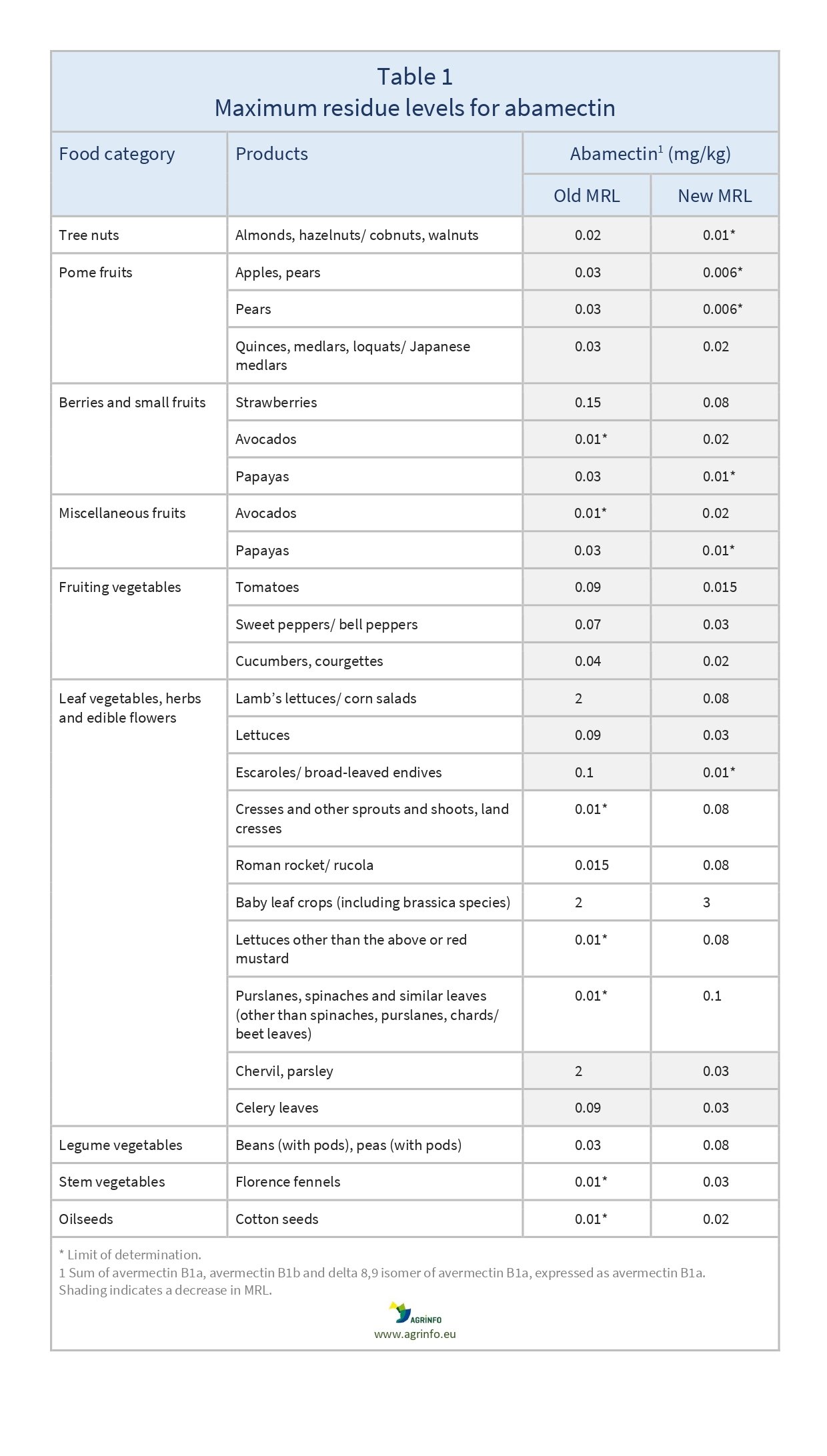Maximum residue levels for abamectin
- Pesticide MRLs
Summary
The EU has amended the maximum residue levels (MRLs) for abamectin. Lower MRLs have been set for certain tree nuts, fruits and fruiting vegetables, and certain salads, but MRLs have increased for other salads, legume vegetables and cotton seeds.
EU amends abamectin MRLs on certain tree nuts, fruits, vegetables and salads from August 2023
Commission Regulation (EU) 2023/198 of 30 January 2023 amending Annex II to Regulation (EC) No 396/2005 of the European Parliament and of the Council as regards maximum residue levels for abamectin in or on certain products
Update
The EU has amended the maximum residue levels (MRLs) for abamectin. Lower MRLs have been set for certain tree nuts, fruits and fruiting vegetables, and certain salads, but MRLs have increased for other salads, legume vegetables and cotton seeds.
Impacted Products
almonds, hazelnuts, cobnuts, walnuts apples, pears, quinces, medlars, loquats, Japanese medlars, strawberries, avocados, papayas, tomatoes, sweet peppers, bell peppers, cucumber, courgettes, lamb’s lettuces, corn salads, lettuces, escaroles, broad leaved endives, cresses, sprouts and shoots, land cresses, Roman rocket, rucola, brassicas, purslanes, chervil, celery leaves, parsley, beans, peas, Florence fennels, seeds
What is changing?
The changes to abamectin MRLs are set out in Table 1.
Why?
EFSA’s evaluation followed a request to modify existing MRLs for certain products (EFSA 2020a), and a request for import tolerances submitted by the USA for certain products in order to prevent barriers to trade (EFSA 2020b). For many products, EFSA established that there was no risk of exceeding the existing acceptable daily intake (ADI) or acute reference dose (ARfD) for abamectin.
However, when reviewing the approval for use of abamectin in the EU, on the basis of developmental neurotoxicity studies, EFSA proposed a lower ADI and ARfD. The European Commission asked EFSA to review certain MRLs in light of the lower ADI and ARfD. This review (EFSA 2021) identified unacceptable risks for a number of products, including apples, pears, strawberries, tomatoes, various salads and sweet peppers.
Timeline
The new MRLs will apply from 20 August 2023.
Recommended Actions
Suppliers of quinces, medlars, loquats/ Japanese medlars, strawberries, tomatoes, sweet peppers/ bell peppers, cucumbers, courgettes, lamb's lettuces/ corn salads, lettuces, chervil, parsley and celery leaves must review existing use of abamectin to ensure conformity of their products with new reduced abamectin MRLs by August 2023.
Suppliers of almonds, hazelnuts/ cobnuts, walnuts, apples, pears, papayas and escaroles/ broad-leaved endives must ensure that alternative solutions are found to existing use of abamectin on these products by August 2023.
Background
MRLs are set in accordance with the rules set out in Regulation 396/2005. For information on current MRLs for other substances, please consult the EU Pesticide Residues database.
Resources
EFSA (2020a) Evaluation of confirmatory data following the Article 12 MRL review and modification of the existing maximum residue levels for abamectin in various commodities. EFSA Journal, 18(1): 5989.
EFSA (2020b) Setting of import tolerances for abamectin in various crops. EFSA Journal, 18(7): e06173.
EFSA (2021) Focussed assessment of certain existing maximum residues levels of concern for abamectin. EFSA Journal, 19(10): 6842.
Sources
Commission Regulation (EU) 2023/198
Tables & Figures

Source: based on Commission Regulation (EU) 2023/198
Disclaimer: Under no circumstances shall COLEAD be liable for any loss, damage, liability or expense incurred or suffered that is claimed to have resulted from the use of information available on this website or any link to external sites. The use of the website is at the user’s sole risk and responsibility. This information platform was created and maintained with the financial support of the European Union. Its contents do not, however, reflect the views of the European Union.
